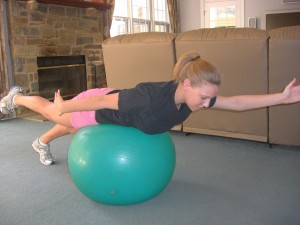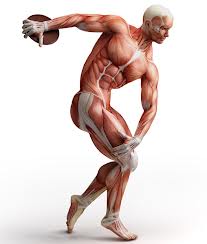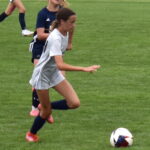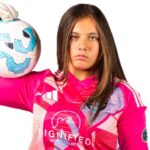Who Needs Core Fitness?
By Dr. Wendy LeBolt
At the Virginia Youth Soccer Association convention last weekend I presented on two topics: Game Fitness and Concussion Protection. The common denominator: Core Fitness. Seem strange? Not really. Because strength in your core muscles – your torso, both front and back – allows you to do two seemingly opposite things, move and hold still. How? Glad you asked…
First, let’s get our lingo straight. Your “core” musculature in the front (anatomists say ventral surface) is primarily your abdominal and chest muscles. In the gym we train these in isolation, performing sit ups and crunches and chest presses or push-ups. Your “core” musculature in the back (dorsal surface – where your dorsal fin would be if you were a fish) is your lower and upper back and rear shoulders.
In the gym we might train the lumbar area with a back extensions using a roman chair and the upper back and shoulders with a rowing machine. Okay, so now we have a great-looking torso. Now what?
The key with fitness for sports is not how it looks but how it works.
That’s why I am a physiologist … who knows just a bit about anatomy.
Core is central to rotational and limb movement.
We move: A strong core offers a stable point against which muscles can pull. All of our movement – kicking, throwing, running, stopping – can happen because the muscles causing the movement have a solid attachment point. (Anatomists call this site the origin.) The muscle fibers are then free to travel out the limb or up to the head and exert a pull on the distant attachment site (the insertion). This causes movement.
f the central, stabilizing attachment site moves (as happens when our core is weak or unstable), the pull of the muscle is ineffective, perhaps negated. I explain this to kids using what I call the ‘dock analogy.’
Picture yourself at your aunt’s summer lake house. You run out to the dock, plant your feet and the last boards and launch yourself into the waves. Splash! Now, imagine if that dock were just floating, unattached below. What would happen? The dock would slip back, you would slip forward. Ouch? Hopefully there would be no injuries.
The second (ouch) is the scenario of folks with weak core muscles trying to use their limbs. Uncoordinated, ineffective movement. And the body, ever in survival mode, will attempt to compensate for the give on one side by shifting on the other. This, perpetuated, is a recipe for injury. (Tim Hewett links a weak trunk to increased risk for ACL injury in this article.)
A strong core is a necessity as the “dock” for strong, coordinated, effective movement.
Balanced core musculature makes us stable and strong.
We hold still. This may be counter-intuitive when we’re discussing sports, but holding still, stability in the challenge, holding our ground, resisting forces that would move us, is as much a part of our game as movement. This becomes even more true in the case of concussion protection.
Concussion, we realize, is a jarring or shaking injury to the brain. It can happen when heads collide with other heads, elbows, other body parts, the ball, the ground, the goal. But it can also happen when the body itself is dealt a forceful blow, no contact to the head, especially when the force causes a whipping, or angular acceleration to the head. The force of impact, if transmitted to the brain inside the skull in a manner that shakes the nerves of the brain, can cause a concussion, or traumatic brain injury.
Recognizing the signs and symptoms of concussion is a primary responsibility of every coach and every parent. Educating kids about the seriousness of this injury is absolutely essential. I call that secondary prevention: prevent a second impact from occurring by recognizing the first and stopping play.
But coaches can participate in primary prevention of this injury by:
*Teaching kids the proper skills to use when heading the ball
*Adopting a gradual progress in this instruction (don’t start by sending corner kicks to diving players who have the sun in their eyes – yes, I caught a coach doing this!)
*Teach and then coach kids to be disciplined in their play. Use more finesse and less force (“accidental” collisions can be reduced)
*Strengthen the core!
Strengthening the core, along with the first three items above, is a first line of defense against this injury.
 Kids with a strong central base of support are less likely to be thrown off balance.
Kids with a strong central base of support are less likely to be thrown off balance.
They’re stronger in the challenge.
They head the ball, reflecting the force of the blow to the ball and not absorbing it with their body.
They’re more likely to come out the winner in any colliding incident.
Coaches, can we build core strengthening into our practice routines and our home fitness expectations? There are tons of fun and effective ways to do this, and not just with isolated exercise. Let’s make this functional, so it’s part of how they move and how they stabilize. Look for my 3 upcoming posts for sample exercises for the field, the gym and the home front.
What’s central to your team’s fitness regime? Are you helping your players build their core? Their foundation? Like everything in life, we hold close what is important. A strong center is what allows us to move and be still. It works.
Editor’s note: This is the latest column from Dr. Wendy Lebolt, a longtime coach and physiologist who is the founder of Fit2Finish, a Northern Virginia-based training, fitness and rehabilitation company which works with teams and individual players to maximize health and performance. The Soccer Wire is excited to present Wendy’s learned perspectives on the mental, physical and psychological aspects of the beautiful game. Learn more about her background here.
SOCCERWIRE MARKETPLACE
- Start the Season Strong at Loudoun Premier Cup!
- 50th Annual Rael Vodicka Memorial Tournament
- Soccer Marketing Internships at The St. James FC
- Job Opening: The St. James FC Goalkeeper Academy Coach
- Full-Time Director of Goalkeeping for The St. James FC
- visitRaleigh.com Showcase Series 2025, hosted by NCFC Youth
- Join Official Elite Summer Soccer Camps with Europe’s Top Pro Clubs!
- OFFICIAL BAYERN MUNICH SUMMER CAMPS U.S.
- OFFICIAL FC BARCELONA CAMPS U.S.
- The Cup San Diego - Hosted by Legends FC












